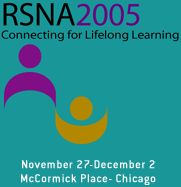
Abstract Archives of the RSNA, 2005
LPR03-05
Improving Temporal and Spatial Resolution for Time-Resolved Pulmonary MR Angiography and Perfusion Imaging at 3.0 Tesla
Scientific Posters
Presented on December 1, 2005
Presented as part of LPR03: Chest (MR Perfusion, Technique)
Kambiz Nael MD, Presenter: Nothing to Disclose
Henrik J. Michaely MD, Abstract Co-Author: Nothing to Disclose
Margaret Hsin-Shung Lee MD, Abstract Co-Author: Nothing to Disclose
Jonathan G. Goldin MD, PhD, Abstract Co-Author: Nothing to Disclose
Gerhard Laub MD, Abstract Co-Author: Nothing to Disclose
Paul Finn MD, Abstract Co-Author: Nothing to Disclose
To implement dynamic pulmonary MRA and perfusion imaging at 3.0 Tesla (3T) by combining high-bandwidth, parallel acquisition and echo-sharing.
20 adult consecutive volunteers (13 M, 7 F, age:31-67) were scanned on a whole body 3T system (Siemens Trio) with an 8 channel body array coil, using a short TR 3D GRE sequence with the following parameters: TR/TE=1.96/0.84 ms; FA=20º; FOV=390 mm²; matrix 320x240; voxel size=1.6x1.2x9 mm³; BW 1300Hz/pixel. When combined with echo sharing and parallel acquisition (GRAPPAx2) the temporal sampling window was 1.6 sec per 3D set. During injection of 6 ml gadodiamide at 4 ml/s, the coronal 3D dataset was acquired repeatedly during a 20 sec breath-hold. Pulmonary arterial (PA) and parenchymal enhancement (PE) phases were reviewed throughout the volume and were scored by two thoracic radiologists. Arterial branches were scored to the highest order visualized, using a 1-5 scale (1 marginal-5 excellent) based on quality and vessel definition. Definition of PE was assessed based on delineation from chest wall & fissures, using a 1-4 scoring scale (1 poor-4 excellent). Interobserver agreement was evaluated by weighted-kappa test.
From the signal intensity time curves, the following indices of perfusion were derived using a gamma variate fit on a pixel by pixel basis :mean transit time (MTT), time to peak (TTP), maximal signal intensity (MSI), maximal upslope of the curve (MUS).
Up to 4th order pulmonary artery branches were visualized in all subjects (100%) with good definition (3.85±0.65, κ= 0.83 ±0.1). PE was identified in all subjects with good definition (3.31±0.58, κ= 0.80±0.11). Perfusion indices showed mean TTP: 5.32 ± 0.93 s, MTT: 7.54 ± 1.06 s, mean MSI: 289 A.U, and mean MSU: 97 A.U/s.
Time-resolved 3D pulmonary MRA and perfusion imaging is feasible at 3T. Combining short TR, echo-sharing and parallel acquisition greatly enhances spatial (in plane: 1.6 x 1.2 mm²) and temporal (1.6 seconds) resolution. Measured perfusion parameters correlate well with established physiological norms.
P.F.: Consultant for Siemens Medical Solutions & GE-Amersham Health CareG.L.: Employee of Siemens Medical Solutions
To implement dynamic pulmonary MRA and perfusion imaging at 3.0 Tesla (3T) by combining high-bandwidth, parallel acquisition and echo-sharing.
20 adult consecutive volunteers (13 M, 7 F, age:31-67) were scanned on a whole body 3T system (Siemens Trio) with an 8 channel body array coil, using a short TR 3D GRE sequence with the following parameters: TR/TE=1.96/0.84 ms; FA=20º; FOV=390 mm²; matrix 320x240; voxel size=1.6x1.2x9 mm³; BW 1300Hz/pixel. When combined with echo sharing and parallel acquisition (GRAPPAx2) the temporal sampling window was 1.6 sec per 3D set. During injection of 6 ml gadodiamide at 4 ml/s, the coronal 3D dataset was acquired repeatedly during a 20 sec breath-hold. Pulmonary arterial (PA) and parenchymal enhancement (PE) phases were reviewed throughout the volume and were scored by two thoracic radiologists. Arterial branches were scored to the highest order visualized, using a 1-5 scale (1 marginal-5 excellent) based on quality and vessel definition. Definition of PE was assessed based on delineation from chest wall & fissures, using a 1-4 scoring scale (1 poor-4 excellent). Interobserver agreement was evaluated by weighted-kappa test.
From the signal intensity time curves, the following indices of perfusion were derived using a gamma variate fit on a pixel by pixel basis :mean transit time (MTT), time to peak (TTP), maximal signal intensity (MSI), maximal upslope of the curve (MUS).
Up to 4th order pulmonary artery branches were visualized in all subjects (100%) with good definition (3.85±0.65, κ= 0.83 ±0.1). PE was identified in all subjects with good definition (3.31±0.58, κ= 0.80±0.11). Perfusion indices showed mean TTP: 5.32 ± 0.93 s, MTT: 7.54 ± 1.06 s, mean MSI: 289 A.U, and mean MSU: 97 A.U/s.
Time-resolved 3D pulmonary MRA and perfusion imaging is feasible at 3T. Combining short TR, echo-sharing and parallel acquisition greatly enhances spatial (in plane: 1.6 x 1.2 mm²) and temporal (1.6 seconds) resolution. Measured perfusion parameters correlate well with established physiological norms.
P.F.: Consultant for Siemens Medical Solutions & GE-Amersham Health CareG.L.: Employee of Siemens Medical Solutions
Nael, K,
Michaely, H,
Lee, M,
Goldin, J,
Laub, G,
Finn, P,
Improving Temporal and Spatial Resolution for Time-Resolved Pulmonary MR Angiography and Perfusion Imaging at 3.0 Tesla. Radiological Society of North America 2005 Scientific Assembly and Annual Meeting, November 27 - December 2, 2005 ,Chicago IL.
http://archive.rsna.org/2005/4415716.html

